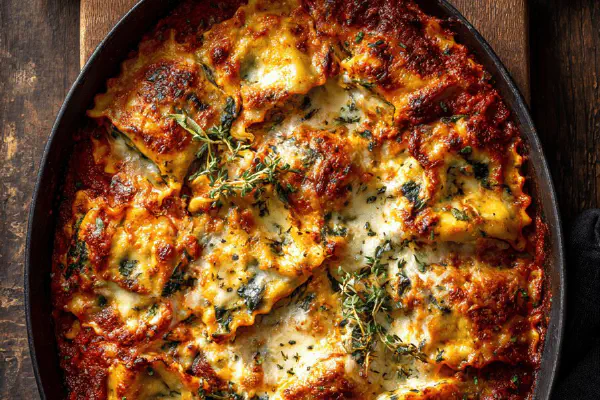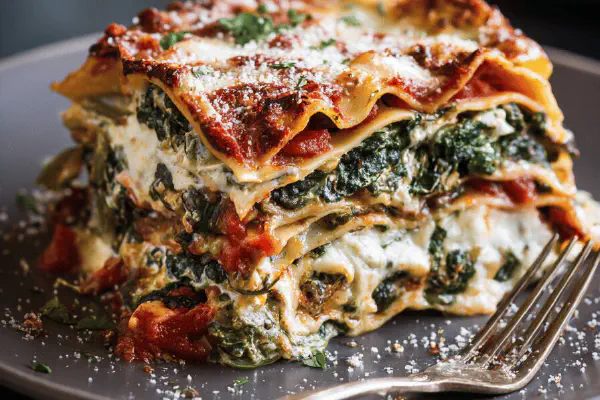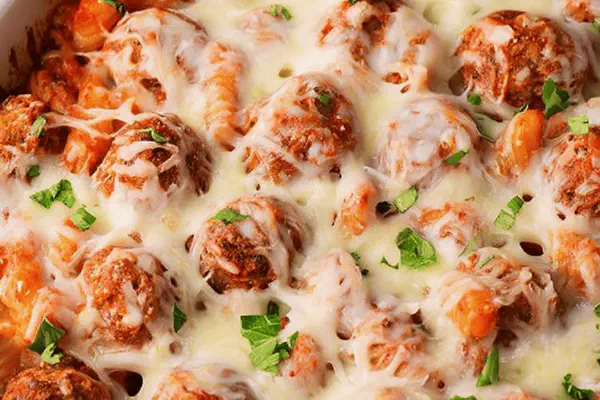Ricotta Spinach Fazzoletti

By Emma
Certified Culinary Professional
Ingredients
Tomato sauce
- 1 medium onion chopped fine
- 3 cloves garlic minced
- 80 ml olive oil
- 1 can 800 ml crushed Italian plum tomatoes, handbroken
- Salt and cracked black pepper
Filling
- 180 g fresh baby spinach roughly chopped
- 25 ml olive oil
- 1 garlic clove minced
- 500 ml whole milk ricotta
- 60 g freshly grated Parmesan
- 120 g shredded provolone cheese instead of mozzarella
- Freshly grated nutmeg to taste
- Salt and freshly cracked pepper
- Fresh pasta sheets for lasagna, cut in half squares (around 350 g)
- Fresh oregano leaves for garnish instead of basil
About the ingredients
Method
Tomato sauce
- Start slipping the onion and garlic gently in olive oil over medium heat. Wait for translucent softness, not brown but soft. Smell starts to build, that garlicky sweetness. Pour in crushed tomatoes. Don’t rush; simmer uncovered letting bubbles break up and thicken sauce. About 20 minutes – watch reducing edges turn deep red, slightly glossy. Season with salt and pepper. Spread half of this into a rectangular baking dish, roughly 33x23 cm.
Filling
- While the sauce simmers, heat a pan with oil and toss in garlic just till fragrant—don’t burn. Chuck spinach in. You want it wilted, dark green but not mush. Shake pan often. Once shriveled, squeeze out excess water—too wet? Will make filling runny and pasta soggy. Let it cool or you’ll scramble the ricotta.
- Mix spinach, ricotta, Parmesan, provolone, nutmeg. Salt and pepper liberally but taste, cheese adds saltiness—a bit too much kills it. The nutmeg wakes up the cheese, subtle but necessary. Set aside.
- Put the pasta squares on a clean surface. Cook them in boiling salted water briefly – al dente, around 45 seconds if fresh. Drain and brush or toss lightly with olive oil so they don’t stick. Lay them flat to cool slightly.
- Spoon about 70 ml of filling into the center of each square. Pinch corners over the top to seal a little pouch; no gaps or filling leaks. Twitch the edges inward, firm but gentle. This keeps the steam inside during baking.
- Arrange these pouches snugly next to each other on the tomato sauce base. Pour remaining sauce carefully on top so the pasta isn’t disturbed. Sprinkle remaining provolone over everything – don’t skimp here, it melts into pockets creating strings and gratins.
- Bake at 175°C (350°F) for 35 minutes. You want bubbling sauce edges, golden cheese spots starting. Use broil/grill for 3-5 minutes if cheese isn’t quite browned — watch carefully or burnt cheese bitterness.
- Garnish with fresh oregano leaves, not basil this time; oregano's piney notes combat the creamy filling well. Serve warm, scraping all that rich bubbling sauce. No leftover sogginess—if soggy, probably overfilled dough or pasta boiled too long.
- Optional tweak: add chopped sun-dried tomatoes to filling for acidity contrast, or sauté mushrooms with spinach for earthiness. Fresh thyme also works with oregano for garnish.
Cooking tips
Chef's notes
- 💡 Drain spinach thoroughly - squeeze with cloth or paper towels. Too much moisture ruins filling. Watery ricotta also runs filling; optionally drain ricotta in cheesecloth a while. No leaks when baking means tight folds.
- 💡 Simmer tomato sauce uncovered; listen for gentle bubbling, see slow thickness forming. Bubbles breaking, sauce gains glossy deep red color. Don’t rush; sauce thinness messes texture in final bake.
- 💡 Fresh pasta sheets cook fast; 45 seconds tops in boiling salted water. Watch timing closely. Drain and brush with olive oil right after so sheets don’t stick or tear. Cool briefly before filling.
- 💡 Fold pasta squares tight; pinch corners neatly. Trapping steam inside is key for juicy pockets. Twitch edges inward gently but firm. Loose seals mean leaks — filling runs out, pasta soggy.
- 💡 Bake at moderate heat first, sauce must bubble, cheese melt fully. Broil last 3-5 mins for golden cheese spots. Watch constantly to prevent burnt bitterness. Oven hot spots uneven—rotate pan if needed.
Common questions
How dry should spinach be?
Spinach moisture enemy here. Must squeeze hard. Use cloth or towels. Watery spinach breaks filling hold. Drenched leaves add soggy mess. Let spinach cool before mixing cheese to avoid scrambling ricotta.
Can I swap provolone for mozzarella?
Yep, provolone sharper, melts stringy. Mozzarella milder but okay. Mixing both works too. For firmer bite add some Parmesan. Keep salt balance in mind since cheeses vary in saltiness.
Why is pasta soggy after baking?
Filling too wet often culprit. Or pasta boiled too long. Fresh pasta cooks fast; overboiling weakens it. Drain spinach well, maybe drain ricotta if watery. Also baking time matters—undercooked sauce or pouches cause sogginess.
How to store leftovers?
Refrigerate covered in airtight container. Reheat in oven to keep texture crisp—microwave makes pasta soggy. Freeze before baking is option; thaw fully then bake. Sauce separate for softer storage if needed.



